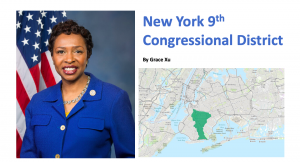
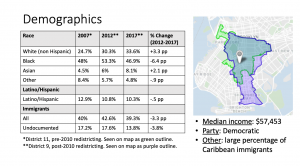
Slide 1: New York’s 9th Congressional District is approximately 33.6% white (non-Hispanic), 46.9% black, and 8.1% Asian. The Latino population is approximately 10% of the population, and the immigration population takes up 39.3% of the population (a third of which is undocumented). The median income is approximately $57,453, which places the majority of the population as either lower class or lower-middle class, and above 10% are unemployed. Before the 2010-2011 redistricting, the district with the most similar borders was District 11 (which District 9’s current congressmember, Yvette D. Clarke, represented). The borders of District 11 in 2009 and District 9 in 2019 are relatively similar, except that District 9 today extends further south to include the neighborhood of Sheepshead Bay, which is majority white. District 11 was 48% black, 24.7% white (non-Hispanic), and 4.5% Asian, as well as 12.9% Hispanic. The immigrant population was approximately 40% of the population. Post-redistricting in 2012, the demographics stood at 30.3% white, 53.3% black, 6% Asian; 10.8% Latino; and 42.6% immigrants. It should be noted that, since 2012, the immigrant population has been decreasing (by about 3.3 percentage points). Several additional features of this population are also important: first, most of the ethnic groups / immigrant groups are concentrated in enclaves. Second, the immigrant and black populations largely overlap because members of NY’s 9th Congressional District tend to be Caribbean. Finally, the Caribbean immigrant community is well established and has been constantly growing since the early 1900s.
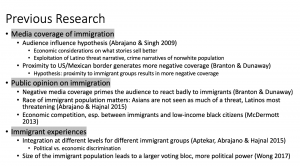
Slide 2: There are mixed opinions on the effect of media coverage on immigration: national news sources tend to portray immigrants in a negative light (Abrajano & Hajnal 2015), but it is difficult to say what part of this is due to local population versus nationwide sentiment. Indeed, Branton and Dunaway suggest that “the size of the foreign-born population is only inconsistently related to negative news coverage of immigration.” However, Abrajano and Singh dispute this with their “audience influence hypothesis”: essentially, since media firms are for-profit, they will consider their economic situation and decide which news their audience “will respond best to. Oftentimes, this results in sensationalized news coverage, and overreporting on issues like immigration. In addition, the media will use certain, easy-to-follow themes like portraying the majority of immigrants as Latinos, or following “crime news scripts,” which portray nonwhite, especially African American actors as criminals (Abrajano & Singh 2009). In addition, Branton and Dunaway themselves suggest that proximity to the US/Mexico border causes more negative coverage, sensationalism, and exploitation of the Latino threat narrative; thus, I extrapolate that populations with more prevalent immigrant issues have more intense and negative local reporting. Public opinion is strongly affected by the media: the media “primes” the audience to respond to immigrants in a certain way, thus fueling negative opinions (Branton and Dunaway 2009). The media does this in two ways: first, through “agenda-setting” (i.e. focusing on immigration a disproportionate amount) and “framing” (i.e. portraying immigration negatively). Negative public opinion, especially from the white population, is also largely shaped by a sudden change in local demographics, like a sudden influx of immigrants (Hopkins); and the race of the immigrants, as whites tend to be less hostile towards Asian Americans and more hostile towards Latinos and blacks (Abrajano & Hanjal 2015). There is also similarly often backlash from black Americans: blacks and low-income men might see immigrants as competitors in jobs (McDermott 2013). As a result, these residents may be less likely to support pro-immigrant policies (i.e. DACA, pathways to citizenship), and more likely to support anti-immigrant policies (i.e. border enforcement). Nevertheless, negative public opinion does not necessarily equate to negative immigrant experiences. Of course, immigrants have negative experiences, which vary between immigrant groups: Asian-Americans, while able to integrate in the sense that they are seen as a “model minority and ally” to whites (Abrajano & Hajnal 2015), can have difficulty penetrating into politics (for example, consider Aptekar’s analysis of Asian Americans in Edison, a community that is successful economically, but not politically); Latinos, on the other hand, are generally treated by white Americans as threats (Abrajano & Hanjal 2015). In addition, it is difficult for immigrants to integrate into local populations: for example, although Caribbean immigrants and African-Americans are of the same “race,” Caribbean Americans tend to form their own communities, instead of integrating into current societies, if black and white racial identities are strong enough (McDermott 2013). At the same time, however, the size of the immigrant population also improves the immigrant population in meaningful ways: more settled immigrants create a better support system for immigrants first arriving to the United States. In addition, the increased size of the immigrant population confers benefits for good policies and representation, as they have become a sizeable voting body. Finally, a district with a strong democratic leaning would also be more partial to supporting permissive and pro-immigrant policies, thus improving immigrant experiences in the district (Wong 2017).
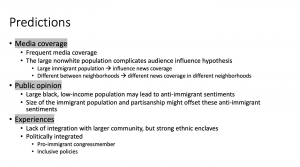
Slide 3: Considering the size of the immigrant population in NY’s 9th Congressional District, I would expect there to be a high salience of media coverage on immigration, since immigration policy is probably pertinent to the large immigrant, and especially undocumented population. In addition, since, in recent years hasn’t been a major or sudden influx of immigrants (indeed, the population of immigrants are decreasing), I’d assume that the media would not have any serious, local situation to capitalize on. negatively Indeed, since there is such a high percentage of nonwhite citizens and such a large immigrant population, local news sources may attempt to pander towards these immigrant populations instead of white citizens. Of course, this also may vary amongst neighborhoods: the immigrant enclaves, for example, may have more pro-immigrant local news; meanwhile, areas like Sheepshead Bay may have more negative local coverage. Generally, however, I expect the news to positive or neutral. The neutrality of the news, combined with the segregation of the immigrant population into enclaves, and the relative lack of “destabilizing change” in the local immigrant population would probably result in a relatively neutral opinion towards immigrants. Furthermore, the fact that 40% of the population is already immigrants (this percent would get higher if we were to count people related to immigrants as well), residents of the district would probably be sympathetic and have positive opinions in regard to new immigrants. However, complicating this is the fact that these immigrants are moving into an area that is already largely lower-income and unemployed, they may be seen as economic competitors against the local population. These negative attitudes may be exacerbated by the size of the local black population. Nevertheless, considering the establishment of the immigrant population, and the fact that the local black population largely intersects with the immigrant population, I believe that, overall, public opinion is positive. I would thus expect support for pro-immigration programs (i.e. DACA, pathways to citizenship). Positive public opinion thus results in a positive immigrant experience. First, considering the enormous size of the immigrant population (consisting of about 40% of the population), I would expect there to be adequate integration (i.e. that local immigrant populations and enclaves would help new immigrants transition into society). Second, because immigrants generate such a large voting bloc in the 9th Congressional District, I would expect good political integration: this means immigrants can elect a congressmember that supports immigration and positive and inclusive immigration policies.
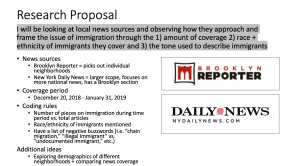
Slide 4: Currently, I am asking someone who lives in the district for suggestions on popular local news sources. From what I have already researched, however, I currently have two fairly district-/borough-specific news sources. First, the Brooklyn Reporter, which has different sections for different neighborhoods; second, the New York Daily News, which is read throughout all of New York City, reports more on national news, but additionally has a Brooklyn section. From these two news sources, I will pull out articles from December 1, 2018 (slightly before the government shutdown) through January 31, 2019 (slightly after the government shutdown). I believe looking at articles around the shutdown is important because it contextualizes why the shutdown happened, and subsequently the opinions on the aftermath of the shutdown. I will primarily be looking at three aspects of news coverage: first, I will count the number of pieces on immigration during this time period and compare it against the number of total articles to see how much focus is placed upon the topic of immigration. Second, of the articles about immigration, I will look at the race and ethnicity of immigrants mentioned. Considering that the majority of immigrants in the 9th Congressional District are Afro-Caribbean, an overrepresentation of other ethnicities of immigrants in local news would demonstrate that media is focused more on sensationalized/stereotypical reporting rather than representing members of the district. Third, of the articles about immigration, I will note the number of negative “buzzwords” they use. An abbreviated list of these buzzwords include: chain migration, illegal immigrant (vs. undocumented immigrant), anchor baby, [insert color here] America. I may also attempt to imitate Abrajano & Hajnal’s experiment of ranking the tone of the articles (by recruiting a random group of people via a survey), if the buzzword check does not work out. If I have time, I would like to compare the different neighborhoods of the 9th Congressional District against each other. First, I would look for the demographics of each neighborhood (i.e. I already know that Sheepshead Bay is majority white). Then, I would find articles about immigration published in each of these neighborhoods and run the aforementioned three tests on the news articles. I would then compare the statistics against each other and see whether the demographics of the neighborhoods had any relation with positive/negative news reporting.